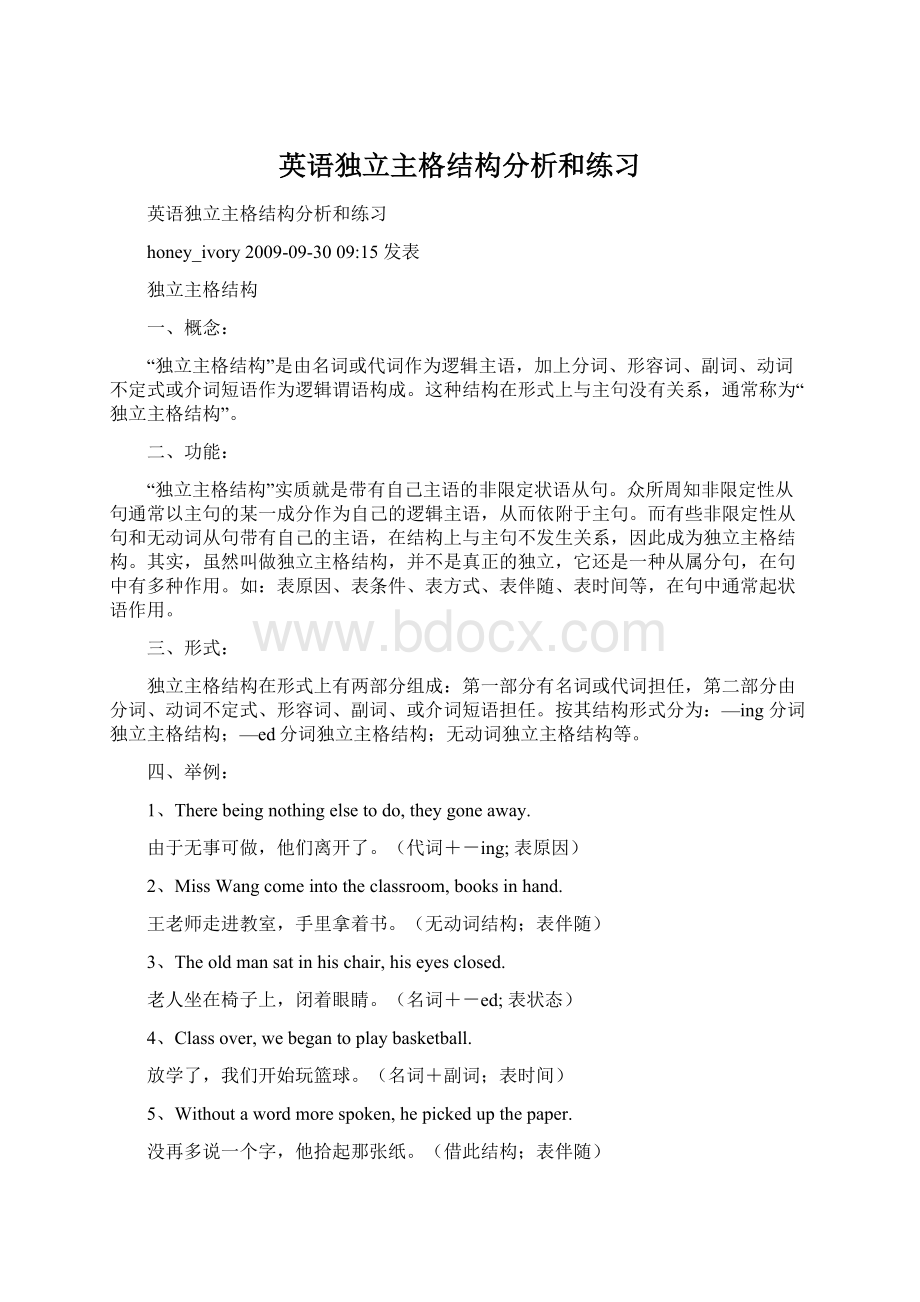英语独立主格结构分析和练习.docx
《英语独立主格结构分析和练习.docx》由会员分享,可在线阅读,更多相关《英语独立主格结构分析和练习.docx(18页珍藏版)》请在冰豆网上搜索。

英语独立主格结构分析和练习
英语独立主格结构分析和练习
honey_ivory2009-09-3009:
15发表
独立主格结构
一、概念:
“独立主格结构”是由名词或代词作为逻辑主语,加上分词、形容词、副词、动词不定式或介词短语作为逻辑谓语构成。
这种结构在形式上与主句没有关系,通常称为“独立主格结构”。
二、功能:
“独立主格结构”实质就是带有自己主语的非限定状语从句。
众所周知非限定性从句通常以主句的某一成分作为自己的逻辑主语,从而依附于主句。
而有些非限定性从句和无动词从句带有自己的主语,在结构上与主句不发生关系,因此成为独立主格结构。
其实,虽然叫做独立主格结构,并不是真正的独立,它还是一种从属分句,在句中有多种作用。
如:
表原因、表条件、表方式、表伴随、表时间等,在句中通常起状语作用。
三、形式:
独立主格结构在形式上有两部分组成:
第一部分有名词或代词担任,第二部分由分词、动词不定式、形容词、副词、或介词短语担任。
按其结构形式分为:
—ing分词独立主格结构;—ed分词独立主格结构;无动词独立主格结构等。
四、举例:
1、Therebeingnothingelsetodo,theygoneaway.
由于无事可做,他们离开了。
(代词+-ing;表原因)
2、MissWangcomeintotheclassroom,booksinhand.
王老师走进教室,手里拿着书。
(无动词结构;表伴随)
3、Theoldmansatinhischair,hiseyesclosed.
老人坐在椅子上,闭着眼睛。
(名词+-ed;表状态)
4、Classover,webegantoplaybasketball.
放学了,我们开始玩篮球。
(名词+副词;表时间)
5、Withoutawordmorespoken,hepickedupthepaper.
没再多说一个字,他拾起那张纸。
(借此结构;表伴随)
6、Thelastguesttoarrive,ourpartywasstarted.
最后一位客人到了,我们的晚会开始了。
(名词+不定式;表时间)
五、独立主格结构与分词短语作状语的异同:
1、独立主格结构与分词短语都可以转化成状语从句。
但是,独立主格结构转换成状语从句后,有自己的逻辑主语,与主句的主语不一致;而分词短语转化为状语从句后,从句的主语与主句的主语相同。
例:
⑴Iftimepermit,we’dbetterhavearestatthisweekend.-→Timepermitting,we’dbetterhavearestatthisweekend.
如果时间允许,本周末我们最好休息一下。
⑵Whenweseefromthetopfloor,wecanfindthegardenmorebeautiful.-→Seeingfromthetopfloor,wecanfindthegardenmorebeautiful.从顶楼上看,花园更漂亮。
2、还应该注意,分词结构的逻辑主语不是总和主句的主语一致,而是主句的其他成分。
语法上称作“依着原则”;有些分词结构在句子上找不到它的逻辑主语,语法上称作“悬垂分词”。
例:
⑴Lookingformywatchintheroom,ithadtakenmealongtime.在屋里找表,用了我很长时间。
(依着原则)
⑵Whenplantingtheseflowers,caremustbetakennottodamagetheroot.(我们)种花时必须小心,不能碰坏花根。
(悬垂分词)
六、独立主格结构与独立成分的异同:
1、有的分词短语可以独立存在,在句子中没有逻辑上的主语,实际上已经成了习惯短语。
这些短语有:
generallyspeaking;franklyspeaking;judgingfrom;supposing等等。
例:
⑴Generallyspeaking,theruleisveryeasytounderstand.总的来说,这个规则很容易懂。
⑵Judgingfromwhathesaid,shemustbeanhonestgirl.根据他所说的,她一定很诚实。
2、有些固定短语是带to的不定式,表明说话人的立场和态度,在句中作独立成分。
这些短语有:
tobehonest;tobesure;totellyouthetruth;tocutalongstoryshort;tobefrank;tomakethematterworse等等。
例:
⑴Totellyouthetruth,whatIsaidatthemeetingwasnotmyopinion.说实话,我在会上说的并不是我的意见。
⑵Tomakethematterworse,helockedhiskeysinthecar.更糟糕的是,他把钥匙锁在车里了
一、非谓语动词独立主格结构
在独立主格结构中,非谓语动词和它前面的名词或代词存在着逻辑上的主谓关系。
Suchanablemantohelpyou,youwillsurelysucceedsoonerorlater.
有这么能干的人来帮你,你迟早一定会成功的。
(suchanableman和tohelpyou之间存在着主谓关系)
=Sincesuchanablemanwillhelpyou,youwillsurelysucceedsoonerorlater.
Heseatinghimselfatthedesk,hismotherbegantotellhimastory.
他在书桌旁坐好后,他母亲开始给他讲故事。
(seatinghimselfatthedesk拥有了自己的逻辑主语he,注意是“主格”)
=Whenheseatedhimselfatthedesk,hismotherbegantotellhimastory.
Thekeytothebikelost,hehadtowalktoschool.
由于丢了自行车钥匙,他只好步行去学校。
(lost的逻辑主语是thekey,lost也可以用完成式havingbeenlost)
=Becausethekeytothebikehadbeenlost,hehadtowalktoschool.
A.不定式“独立主格结构”
在“逻辑主语+动词不定式”结构中,动词不定式和它前面的名词或代词存在着逻辑上的主谓关系。
这种结构也可用一个从句或并列分句来表达。
1.动词不定式用主动的形式
在独立主格结构中,动词不定式和它前面的名词或代词存在着逻辑上的主谓关系。
Hismothertocometonight,heisbusypreparingthedinner.
他母亲今晚要来,他正在忙着准备饭菜。
(=Ashismotheristocometonight,heisbusypreparingthedinner.)
——willyougotothecomcerttonight你今晚去听音乐会吗?
——sorry.Somanyexerise-bookstocheck,Iriallycan'taffordanytime.
对不起,有这多的作业要批,我真的抽不出时间。
(=BecauseIshallchecksomanyexercise-bookstonight,Ireallycan'taffordanytime.)
Thefourofusagreedonadivisionoflabour,eachtotranslateaquarterofthebook.
我们四人同意分工干,每人翻译全书的四分之一。
(=Thefourofusagreedonadivisionoflabourandeachistotranslateaquarterofthebook.)
Manytrees,flowers,andgrasstobeplanted,ournewly-builtschoolwilllookevenmorebeautiful.种上许多的树,花和草后,我们新建的学校将看上去更美。
(=Ifmanytrees,flowers,andgrassareplanted,ournewly-builtschoolwilllookevenmorebeautiful.)
B.-ing形式“独立主格结构”
动词的-ing形式作状语时,其逻辑主语一般应与句子的主语保持一致。
Beingill,hewenthome.
由于生病,他回家了。
(=Ashewasveryill,hewenthome.)
Seatinghimselfatthedesk,hebegantoreadamagazine.
在课桌旁坐好后,他开始看杂志。
(=Whenhehadseatedhimselfatthedesk,hebegantoreadamagazine.)
1.表示时间的-ing形式作“独立主格结构”
Everyonebeingready,theteacherbeganhisclass.
每个人都准备好后,老师开始上课。
(相当于一个时间状语从句Wheneveryonewas
ready)
Thechairmanbeganthemeeting,everyonebeingseated.
每个人坐好后,主席开始开会。
(相当于一个时间状语从句aftereveryonewasseated)
2.表示原因的-ing形式作“独立主格结构”
Theboyleadingtheway,wehadnotroublefindingthestrangecave.由那个男孩带路,我们没有困难就找到了那奇怪的洞。
(相当于一个原因状语从句Becausetheboyledtheway)
Manyeyeswatchinghim,hefeltabitnervous.许多眼睛看着他,他感到有点儿紧张。
(相当于一个原因状语从句Asmanyeyeswerewatchinghim)
必背:
含有being的独立主格结构。
ItbeingNationalDaytoday,thestreetsareverycrowded.今天是国庆节,街上很拥挤。
=AsitisNationalDaytoday,thestreetsareverycrowded.
Therebeingnofurtherbusinesstodiscuss,weallwenthome.没有别的事可讨论,我们都回家了。
=Astherewasnofurtherbusinesstodiscuss,weallwenthome.
3.表示条件的-ing形式作“独立主格结构”
Timepermitting,wewillhaveapicnicnextweek.
时间允许的话,我们下星期将进行一次野炊。
(相当于一个条件状语从句Iftime
permits)
Myhealthallowing,Iwillworkfarintothenight.
我的健康许可的话,我愿工作到深夜。
(相当于一个条件状语从句Ifmyhealthallows)
4.表示方式的-ing形式作“独立主格结构”
Thestudentsarewalkingintheschoolhappily,eachwearingacardinfrontofhischest.
学生们快乐地在学校里走着,每个人胸前都带着一张卡。
(相当于一个并列分句andeachwearsacardinfrontofhischest)
Theboylayonthegrass,hiseyeslookingatthesky.
男孩躺在草地上,眼睛看着天空。
(相当于一个并列分句andhiseyeswerelookingatthesky)
C.-ed形式“独立主格结构”
与逻辑主语+动词的-ing形式一样,如果-ed形式的逻辑主语和句子的主语不一致的话,就需要用-ed形式的独立主格结构。
ThebookwritteninsimpleEnglish,Englishbeginnerswereabletoreadit.
该书是用简单英语写的,英语初学者也能看懂。
=AsthebookwaswritteninsimpleEnglish,Englishbeginnerswereabletoreadit.
Theworkersworkedstillharder,theirlivingconditionsgreatlyimproved.
由于工人们的生活条件大大提高,他们工作得更起劲了。
=Astheirlivingconditionsweregreatlyimproved,theworkersworkedstillharder.
Hewaslisteningattentivelyinclass,hiseyesfixedontheblackboard.
他上课专心听讲,眼睛紧盯着黑板。
=Hewaslisteningattentivelyinclass,andhiseyeswerefixedontheblackboard.
Thetaskcompleted,hehadtwomonths'leave.
任务完成以后,他休了两个月的假。
(=Whenthetaskhadbeencompleted,hehadtwomonths'leave.)
比较:
动词不定式表示动作没有发生或即将发生,动词-ed形式表示动作已经结束,动词-ing形式往往表示动作正在进行。
Themanagerlooksworried,manythingstosettle.经理看上去很着急,有这么多的事情要处理。
(事情还没有处理,而且是由经理本人来处理,用不定式tosettle)
Themanagerlooksrelaxed,manythingssettled.许多事情已经处理好了,经理看上去很轻松。
(事情已经处理好了,用动词-ed形式settled表示动作已经结束)
Thefoodbeingcooked,theboywaswatchingTV.小孩一边做饭,一边看电视。
(两个动作同时进行)
Thefoodcooked,theboywenttobed.饭做好了,小孩去睡了。
(两个动作有先后,饭已做好,小孩才去睡觉的
二、with、without引导的独立主格结构
介词withwithout+宾语+宾语的补足语可以构成独立主格结构,上面讨论过的独立主格结构的几种情况在此结构中都能体现。
A.with+名词代词+形容词
Hedoesn誸liketosleepwiththewindowsopen.
他不喜欢开着窗子睡觉。
=Hedoesn誸liketosleepwhenthewindowsareopen.
Hestoodintherain,withhisclotheswet.
他站在雨中,衣服湿透了。
=Hestoodintherain,andhisclotheswerewet.
注意:
在“with+名词代词+形容词”构成的独立主格结构中,也可用已形容词化的-ing形式或-ed形式。
Withhissonsodisappointing,theoldmanfeltunhappy.
由于儿子如此令人失望,老人感到很不快乐。
Withhisfatherwell-known,theboydidn誸wanttostudy.
父亲如此出名,儿子不想读书。
B.with+名词代词+副词
Ourschoollooksevenmorebeautifulwithallthelightson.
所有的灯都打开时,我们的学校看上去更美。
=Ourschoollooksevenmorebeautifulifwhenallthelightsareon.
Theboywaswalking,withhisfatherahead.
父亲在前,小孩在后走着。
=Theboywaswalkingandhisfatherwasahead.
C.with+名词代词+介词短语
Hestoodatthedoor,withacomputerinhishand.或
Hestoodatthedoor,computerinhand.
他站在门口,手里拿着一部电脑。
=Hestoodatthedoor,andacomputerwasinhishand.
Vincentsatatthedesk,withapeninhismouth.或
Vincentsatatthedesk,peninmouth.
文森特坐在课桌前,嘴里衔着一支笔。
=Vincentsatatthedesk,andhehadapeninhismouth.
D.with+名词代词+动词的-ed形式
Withhishomeworkdone,Peterwentouttoplay.
作业做好了,彼得出去玩了。
=Whenhishomeworkwasdone,Peterwentouttoplay.
Withthesignalgiven,thetrainstarted.
信号发出了,火车开始起动了。
=Afterthesignalwasgiven,thetrainstarted.
Iwouldn誸daregohomewithoutthejobfinished.
工作还没完成,我不敢回家。
=Iwouldn誸daregohomebecausethejobwasnotfinished.
E.with+名词代词+动词的-ing形式
Themanfeltveryhappywithsomanychildrensittingaroundhim.
有这么多的孩子坐在他周围,那男子感到很高兴。
=Themanfeltveryhappywhenhefoundsomanychildrensittingaroundhim.
Thegirlhidherboxwithoutanyoneknowingwhereitwas.
小女孩把盒子藏了起来,没有人知道它在哪里。
=Thegirlhidherboxandnooneknewwhereitwas.
Withoutanyonenoticing,heslippedthroughthewindow.他趁没人注意的时候,从窗口溜走了。
=Whennoonewasnoticing,heslippedthroughthewindow.
F.with+名词代词+动词不定式
Thelittleboylookssad,withsomuchhomeworktodo.
有这么多的家庭作业要做,小男孩看上去很不开心。
=Thelittleboylookssadbecausehehassomuchhomeworktodo.
Thekidfeelsexcitedwithsomanyplacesofinteresttovisit.
有这么多的名胜可参观,小孩很激动。
Thekidfeelsexcitedastherearesomanyplacesofinteresttovisit.
提示:
在withwithout的复合结构中,多数情况下with能省略,但without不能省略。
Withoutawordmorespoken,sheleftthemeetingroom.
她没再说什么话就离开了会议室。
(without不能省略)
四、独立主格结构的句法功能
独立主格结构在句中除了能充当原因状语、时间状语、条件状语和伴随状语外,还能作定语。
在形式上,“独立主格结构”可位于句首、句中或句尾,并通常用逗号与主句隔开。
A.作状语
独立主格结构作状语,其功能相当于一个状语从句或并列分句。
1.表示时间
Nightcomingon,weputourselvesupinasmallhotel.夜幕降临,我们在一家小旅馆住了下来。
(=Whennightcameon,weputourselvesupinasmallhotel.)
Alltheguestsseated,theybegantheirdinner.
所有的客人就坐后,他们才开始吃饭。
(=Whenalltheguestswereseated,theybegantheirdinner.)
Witheverythingsheneededbought,Gracetookataxihome.
所需要的都买好后,格雷斯打的回家了。
(Aftereverythingsheneededwasbought,Gracetookataxihome.)
2.表示原因
Withalotofdifficultproblemstosettle,thenewly-electedpresidentishavingahardtime.
有许多难题要解决,新当选的总统日子不好过。
(=Ashehasalotofdifficultproblemstosettle,thenewly-electedpresidentishavingahardtime.)